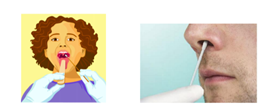Sensory Blog- Covid-19 Testing Success Tips
Sensory Support during medical procedures: Covid-19 testing Success tips
Guest blog written by Occupational Therapy Assistant Student, Juliana Lehman OTAS
Advisement, Editing and Supervision by Deborah Bebeau EdD, OTR
Fear and anxiety often surround medical procedures for everyone, but the feelings can be more intense for children. Now with the new normal of certain medical procedures requiring the addition of a Covid-19 test before being seen in a clinic, kids will look to their parents and caregivers to guide and model behavior.
Here are some things to consider for helping your child to feel more secure, comfortable, and be a more willing participant.
- For the best possible outcome, plan to take some time to prepare your child beforehand. Ask about their questions and fears.
- If non-verbal try an Augmentative Alternative Communication device or (AAC). A child could be asked to show a visual or display on their device what conveys their feelings and concerns about the test.
- Include an explanation of why it is necessary to be tested, spell this out in a way that you think best works for your child, clarify that the doctor can better care for the child by knowing if there has been any exposure to this virus.
- Define the unfamiliar words in a kid-friendly way. Take virus for example: say it is like a germ, but so small that it can’t be seen…some people get sick when they breathe it in from the air but others feel fine but may test positive for the virus.
- If non-verbal try an Augmentative Alternative Communication device or (AAC). A child could be asked to show a visual or display on their device what conveys their feelings and concerns about the test.
- Make a decision based upon your child’s capabilities, let your kiddo be the guide as to where to get the Covid-19 test performed.
- Three options are available, two in-person, and one as an at-home test kit.
- The in-person tests include a drive through where you remain in your vehicle and enter a tent or the other a more traditional, medical in-clinic setting.
- To request an at-home kit:
- Go to https://www.dhs.wisconsin.gov/covid-19/collection.htm
- Request the kit, free of charge at this time
- Collect the sample in the presence of a healthcare professional over Zoom
- Send in the sample via UPS to a lab
- Consider which feels best and try including a favorite object to hug and maybe have music on in the background.
- Reassure them that you will stay close-by and can hold their hand if they so choose.
- Do some deep breathing before it starts.
- Count to three as the procedure happens.
- Do a pretend run-through with a sibling or friend play-acting out the scene.
- For children who are tactilely defensive, demonstrate modeling appropriate behavior. Have others pretend to be tested, then the child, practice this at home.
- Three options are available, two in-person, and one as an at-home test kit.
- Use online preparation tools for visual support, this will enable meaningful connections (Narzisi,2020):
- Social Stories: detailed and simple stories from Massachusetts General Hospital (Thom,2020)
- Videos: COVID-19 Video Teaching Story from University of Miami – NSU (autismspeaks.org, 2020)
- https://www.mayoclinic.org/vid-20483784 (a kid friendly video)
The test uses a swab or Q-tip that swipes the inside of your nose or back of mouth
Credit: Meg Stone-Heaberlin, PsyD (2020)
Consider next the other sensory encounters—what will be seen?
A doctor or nurse wearing extra protective equipment, more than just a mask and gloves, often a full hazmat suit may be present.
Remind kids that it is a kind person under the strange safety dress up, cue them to watch the eyes of the doctor or nurse to see the telltale corner crinkles around their eyes showing that they are smiling at you.
What will be heard? Depending on the environment chosen, traffic noise, elevator music, other people in the waiting area. What might the smells be? Alcohol-based antiseptic, and sterile or cleaning supply smells may be present.
What does the test entail? For a pharyngeal swab, a long, skinny cotton covered swab will be put into your nose and pushed far back for a short time to collect a sample. For an anterior nasal swab (front of nose) the swab is swished around longer but not inserted as far into the nose. Also, a saliva test for Covid-19 exists, this is less invasive that the other two and involves spitting in a collection funnel (Bryne, 2020).
What will this feel like? The nasal swabs may be uncomfortable and tickle. How will you want to react? By pushing the swab away but stay still it will be over quickly.
Even after intense preparation, and practice some children, particularly those with a diagnosis of Autism Spectrum Disorder (ASD), or with developmental delays may find the test too challenging and not be able to complete it. Ask ahead of time if a Child Life Specialist is available who may be able to provide videos or photos specific to the setting where the child is scheduled for an appointment.
If this is the case, consult with your child’s pediatrician or health provider to manage symptomatology and together you can decide how to best handle the situation and try alternate Covid-19 testing methods or find a way to still be able to receive treatment and develop a care routine that works.
Disclaimer: By referencing products or services this author does not directly or indirectly endorse any specific product or services. This blog is for informational purposes only and is not intended to give medical advice. Please consult with your child’s physician or licensed practitioner and consider the individual needs of your child.
Sources :
Narzisi, A. (2020). Handle the Autism Spectrum Condition during Coronavirus (COVID-19) Stay at Home Period: Ten Tips for Helping Parents and Caregivers of Young Children. Brain Sciences (2076-3425), 10(4), 207. https://doi.org/10.3390/brainsci10040207
Narzisi, A. (2020). Autism Spectrum Condition and COVID-19: Issues and Chances. Humanistic Psychologist, 48(4), 378–381. https://doi.org/10.1037/hum0000221
https://www.health.harvard.edu/blog/helping-people-with-autism-spectrum-disorder-manage-masks-and-covid-19-tests-2020061020089
https://www.autismspeaks.org/covid-19-information-and-resources-families
Council for Exceptional Children, the Division for Learning Disabilities (DLD) and the Division for Research (DR). Graphic Organizers: Power Tools for Teaching Students with Learning Disabilities (528K PDF)*.
56 Resources To Help Families During COVID 19 by JimHolsomback
Byrne, R. L., Kay, G. A., Kontogianni, K., Aljayyoussi, G., Brown, L., Collins, A. M….Cubas-Atienzar, A. I. (2020). Saliva Alternative to Upper Respiratory Swabs for SARS-CoV-2 Diagnosis. Emerging Infectious Diseases, 26(11), 2769-2770. https://dx.doi.org/10.3201/eid2611.203283.
Recent Posts





